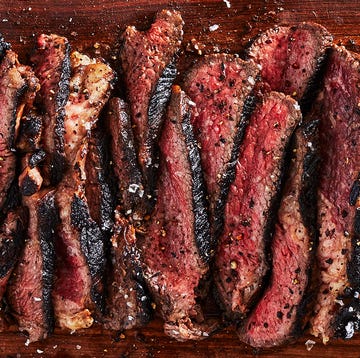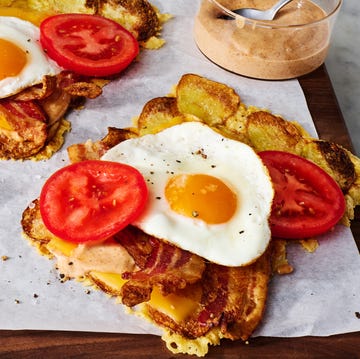The origin story of jerk is one of preservation. Before European conquest, slavery, and, finally emancipation, the indigenous people of Jamaica, the Taíno, perfected the art of jerk. It’s a fitting metaphor for survival and an implicit slap in the face to their colonizers: We will survive, and thrive, no matter what you do to us. The Taíno passed along their jerk-making skills to their sisters and brothers in resistance, enslaved Africans.
But what is jerk? It’s a way to preserve meat, a marinade, and a cooking method, as Jamaicans will tell you. (They are also quite confident in their own version of jerk and are quick to let you know that so-and-so’s is the best. My Jamaican immigrant parents looked down upon adding onions, for example.)
A recent trip back to my second “home” meant relaxation—and a scouting trip to find the perfect version. I landed on the jerk stand Best in the West, which locals insist is Number One. One of the pitmasters shared some pointers. Notably: There MUST be soy sauce (we thank 19th-century Chinese immigrants to the island for this contribution). Also, no onions, and not too many Scotch bonnet peppers (which could detonate on the palate like an atom bomb). And most importantly, you have to babysit and coddle it while it cooks: low-to-medium heat, flipping and basting every now and then.
My jerk chicken delivers a subtle kick from the peppers; woodsy warmth from the nutmeg, cloves, and allspice; savoriness from soy sauce; grassy freshness from scallions. And no onions.
How To Make Jamaican Jerk Chicken
INGREDIENTS
- Chiles: Scotch bonnet is the traditional chile in jerk, but habanero is a more than acceptable replacement. Both pack about the same punch, but Scotch bonnets tend to be a little more floral.
- Scallions: An entire bunch of scallions add a fresh, herbal, nuanced allium flavor that complements the marinade’s chile heat and spice warmth.
- Garlic: Garlic brings aromatic depth and a slightly spicy allium kick to the marinade.
- Ginger: A signature jerk flavor, ginger is a mark of West Africa’s influence on Jamaican cooking.
- Brown Sugar: I use brown sugar to temper the chiles’ considerable heat as well as to bring a caramel-like depth to the marinade. The sugar also helps give the chicken a gorgeously charred exterior.
- Pineapple Juice: Pineapple juice lends bright acidity and subtle sweetness to the marinade, while adding a tropical flavor that works well with jerk’s herbal and smoky notes. If that weren’t enough, the juice also contains potent enzymes that help tenderize the chicken.
- Soy Sauce: This one might come as a surprise, but Jamaica has been a crossroads culture for ages, and soy sauce has long been a common ingredient in jerk marinades, giving them a boost of umami.
- Thyme: Jerk marinade leans heavily on thyme. Conveniently, there’s no need to strip leaves from stem after stem—just toss the entire sprigs into the blender and blitz until smooth.
- Allspice: Perhaps the signature flavor of Jamaican cooking, allspice (aka pimento) contributes a sweet spice warmth that carries echoes of cloves, cinnamon, and nutmeg. It has a remarkable ability to tie the many flavors of the marinade into a complex whole.
- Bay Leaf: There for earthy, herbal depth.
- Nutmeg: Adds more warm, sweet-spice notes and reinforces the allspice.
- Black Peppercorns: Provide slow-burn heat and a woodsy, earthy warmth.
- Cloves: Work hand-in-hand with the nutmeg to enhance the allspice.
- Chicken: I like to start with a whole chicken and break it down into parts—it tends to be more economical and leaves me with a carcass that I use for stock. That said, any combination of skin-on, bone-in chicken parts—white meat, dark meat, or a mix—will work perfectly.
- Ketchup: Toward the end of grilling, I like to brush the chicken with a glaze of ketchup and soy sauce glaze. The simple combination works wonders, infusing the chicken with deep umami flavor and guaranteeing a beautiful char.
STEP-BY-STEP INSTRUCTIONS
First step: Blend all the marinade ingredients—everything from the chiles through the soy sauce—to a smooth puree. A high-power blender is ideal but a standard blender, given a little extra time, will work just fine. Be sure to start blending on low speed and gradually work your way up to high.
Set aside 1/2 cup marinade for serving; cover and chill. Pour the rest of the marinade into a large bowl. Add the chicken and massage the marinade into each piece. Cover and refrigerate for at least 8 hours and up to 12.
When you’re ready to grill, stir together the ketchup and soy sauce and place nearby. A charcoal grill will infuse the jerk with a distinct smokiness, but I’m here to tell you a gas grill or even, as here, a grill pan can turn out excellent jerk. Preheat your grill pan over high heat until it’s ripping hot. Brush the pan with oil to create a nonstick barrier. My preferred technique: Hold a wadded paper towel with tongs, dip the towel in oil, then lightly brush the pan. Wait 30 seconds, then brush again.
Reduce the heat to medium and arrange the marinated chicken, skin side down, in the pan; work in batches to avoid overcrowding. Grill, turning and brushing with marinade occasionally, until grill marks form and the chicken is just a few minutes away from being cooked through.
Now, brush the chicken on both sides with the ketchup mixture and continue to cook, turning occasionally, until well charred and an instant-read thermometer inserted into the thickest part of a piece registers 165°. White meat pieces should take 8 to 10 minutes total; dark meat, 12 to 15 minutes.
Transfer the chicken to a platter or divide it among plates. Top with chopped cilantro and/or sliced scallions. Serve with lime wedges and the reserved marinade.
Full list of ingredients and directions can be found in the recipe below.
Recipe Tips
- An easier way to peel garlic: The jerk marinade calls for a whole lot of garlic. Save yourself time and trouble by soaking the unpeeled cloves in a bowl of hot water. After about 10 minutes, the peels should easily slip right off.
- The best way to remove seeds from a Scotch bonnet or habanero chile: Trust me, you don’t want to handle chiles as hot as these with your bare hands. Instead, use gloves or else try this nifty trick: Spear the chile near the stem with a fork, then cut the flesh away from the seeds and stem while rotating the chile with the fork. Easy-peasy!
Storage
Any leftover jerk chicken can be stored in an airtight container in the fridge for up to 3 days. Reheat in a 325° oven.



















